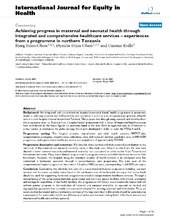| dc.description.abstract | Background: An integrated and comprehensive hospital/community based health programme is presented, aimed at reducing maternal and child mortality and morbidity. It is run as part of a general programme of health care at a rural hospital situated in northern Tanzania. The purpose was through using research and statistics from the programme area, to illustrate how a hospital-based programme with a vision of integrated healthcare may have contributed to the lower figures on mortality found in the area. Such an approach may be of interest to policy makers, in relation to the global strategy that is now developed in order to meet the MDGs 4 and 5. Programme setting: The hospital provides reproductive and child health services, PMTCT-plus, comprehensive emergency obstetric care, ambulance, radio and transport services, paediatric care, an HIV/AIDS programme, and a generalised healthcare service to a population of approximately 500 000. Programme description and outcomes: We describe these services and their potential contribution to the reduction of the maternal and neonatal mortality ratios in the study area. Several studies from this area have showed a lower maternal mortality and neonatal mortality ratio compared to other studies from Tanzania and the national estimates. Many donor-funded programmes focusing on maternal and child health are vertical in their framework. However, the hospital, being the dominant supplier of health services in its catchment area, has maintained a horizontal approach through a comprehensive care programme. The total cost of the comprehensive hospital programme described is 3.2 million USD per year, corresponding to 6.4 USD per capita. Conclusion: Considering the relatively low cost of a comprehensive hospital programme including outreach services and the lower mortality ratios found in the catchment area of the hospital, we argue that donor funds should be used for supporting horizontal programmes aimed at comprehensive healthcare services. Through a strengthening of the collaboration between government and voluntary agency facilities, with clinical, preventive and managerial capabilities of the health facilities, the programmes will have a more sustainable impact and will achieve greater progress in the reduction of maternal and neonatal mortality, as opposed to vertical and segregated programmes that currently are commonly adopted for averting maternal and child deaths. Thus, we conclude that horizontal and comprehensive services of the type described in this article should be considered as a prerequisite for sustainable health care delivery at all policy and decision-making levels of the local, national and international health care delivery pyramid. | en_US |

